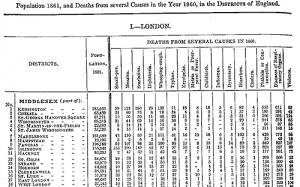Mortality in the metropolis, 1860-1920

The aim of the project is to investigate patterns of mortality in London during a period which witnessed major change in both the incidence and the causes of death.
The project will produce a cause-specific mortality database, using the Registrar-General's annual figures. The data will be used to illuminate processes underlying epidemiological change and its relationship to a series of broad indicators of the changing social and environmental character of the metropolis as a whole and each registration district within it. Micro-studies of two carefully-selected districts explore local conditions and epidemiological experiences in much more detail, and juxtapose that picture with the aggregate pattern. They assess the health status of individual localities in relation to the extent of medical provision, access to that provision, and the political or bureaucratic response to crisis.
Publications
Graham Mooney, 'Did London pass the "sanitary test"? Seasonal infant mortality in London, 1870-1914', Journal of Historical Geography, 20 no. 2 (1994), 158-74; Graham Mooney and N. Williams, 'Infant mortality in an "Age of Great Cities"; London and the provincial cities compared, c.1840-1910', Continuity and Change, 9 no.2 (1994), 185-212; Graham Mooney, 'Still-births and the measurement of urban infant mortality in England, 1890-1930', Local Population Studies, 53 (1994), 42-52; Graham Mooney 'The prevention and control of infectious childhood diseases in late nineteenth- and early twentieth-century London: the case of diphtheria and measles', in M.L. Gentileschi and R. King (eds), Questioni di Popolazione in Europa: una Prospettiva Geografica (Associazione dei Geografi Italiani and Institute of British Geographers; Bologna, 1996), 255-271; Bill Luckin, 'Perspectives on the mortality decline in London, 1860-1920', The London Journal, 22 (1997), 123-41; Bill Luckin, 'Town, Country and Metropolis: the formation of an air pollution problem in London, 1800-1870', in D. Schott (ed), Energie und Stadt in Europa: Von der Vorindustriellen, Hollznot' bis zur Olkrise der 1970er Jahre (Stuttgart, 1997), 78-92; Bill Luckin and Graham Mooney, 'Urban history and historical epidemiology: the case of London, 1860-1920', Urban History, 24 (1997), 37-54; Graham Mooney, 'Professionalization in public health and the measurement of sanitary progress in nineteenth-century England and Wales', Social History of Medicine, 10 (1997), 53-78; Graham Mooney, '"A tissue of the most flagrant anomalies": smallpox and the centralisation of sanitary administration in late nineteenth-century London', Medical History, 41 (1997), 261-90; Graham Mooney and Simon Szreter, 'Urbanization, mortality, and the standard of living debate: new estimates of the expectation of life at birth in nineteenth-century British cities', Economic History Review LI (11998), 84-112; Andrea Tanner, 'Thomas Orme Dudfield: the model medical officer of health', Journal of Medical Biography, 6 (1998), 79-85; Andrea Tanner, 'A troublesome priest. A Victorian Workhouse Chaplain in the City of London', London Journal, XXIII (1998), 15-31; Andrea Tanner, 'The casual poor and the City of London Poor Law Union, 1837-1869', The Historical Journal, 42 (1999), 183-206; Bill Luckin, Graham Mooney and Andrea Tanner, 'Patient pathways: solving the problem of institutional deaths in late nineteenth-century London', Social History of Medicine, 12:2 (1999), 227-69; Graham Mooney, 'Public health versus private practice: the contested development of compulsory infectious disease notification in late nineteenth-century Britain', Bulletin of the History of Medicine, 73 (1999), 238-67; Andrea Tanner, 'Scarlatina and sewer smells, metropolitan public health records, 1860-1920', International Network for the History of Public Health Electronic Journal (October 1999); Graham Mooney, 'The epidemiological implications of reconstructing hospital catchment areas in Victorian London', in M. Woollard (ed.), New Windows on London's Past: Information Technology and the Transformation of Metropolitan History (Association for History and Computing (UK), 2000), pp. 47-74; Graham Mooney and Andrea Tanner, 'Infant mortality, a spatial problem: Notting Dale special area in George Newman's London', in E. Garrett, C. Galley, N. Shelton and R. Woods (eds.), Infant Mortality: A Continuing Social Problem (Ashgate, 2007)
Reports
CMH Annual Reports 1994-5, 1995-6, 1996-7, 1997-8, Tenth Anniversary Conference paper, 1998-9, extract from End of Award Report (Wellcome)
Project details
Researchers: William Luckin, B.A., M.Sc., Graham Mooney, B.A., Ph.D., Andrea Tanner, B.A., M.A., Ph.D.
Research Assistant: Patsy Pinedo Tuck, B.A. (10 June-9 August 1996)
Funded by: The Wellcome Trust (1 July 1995-1999)
Amount Awarded: £177,081
